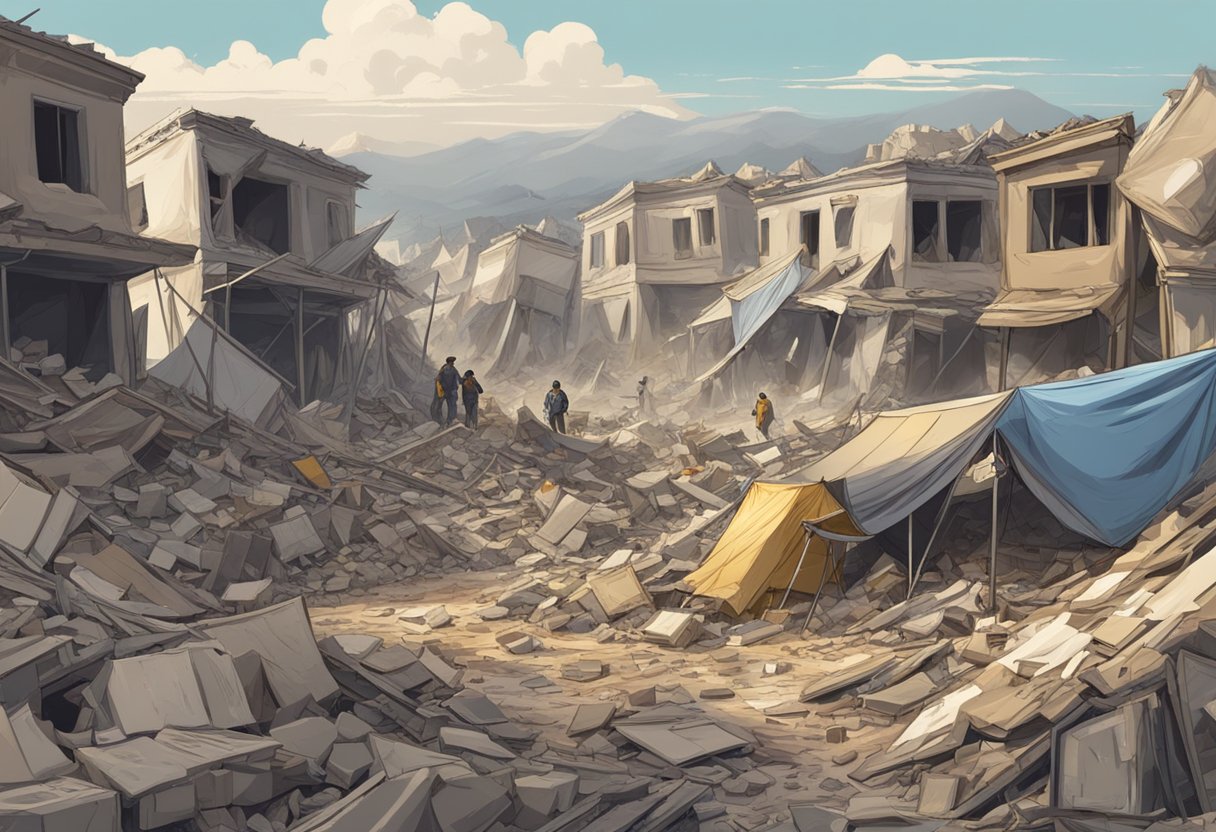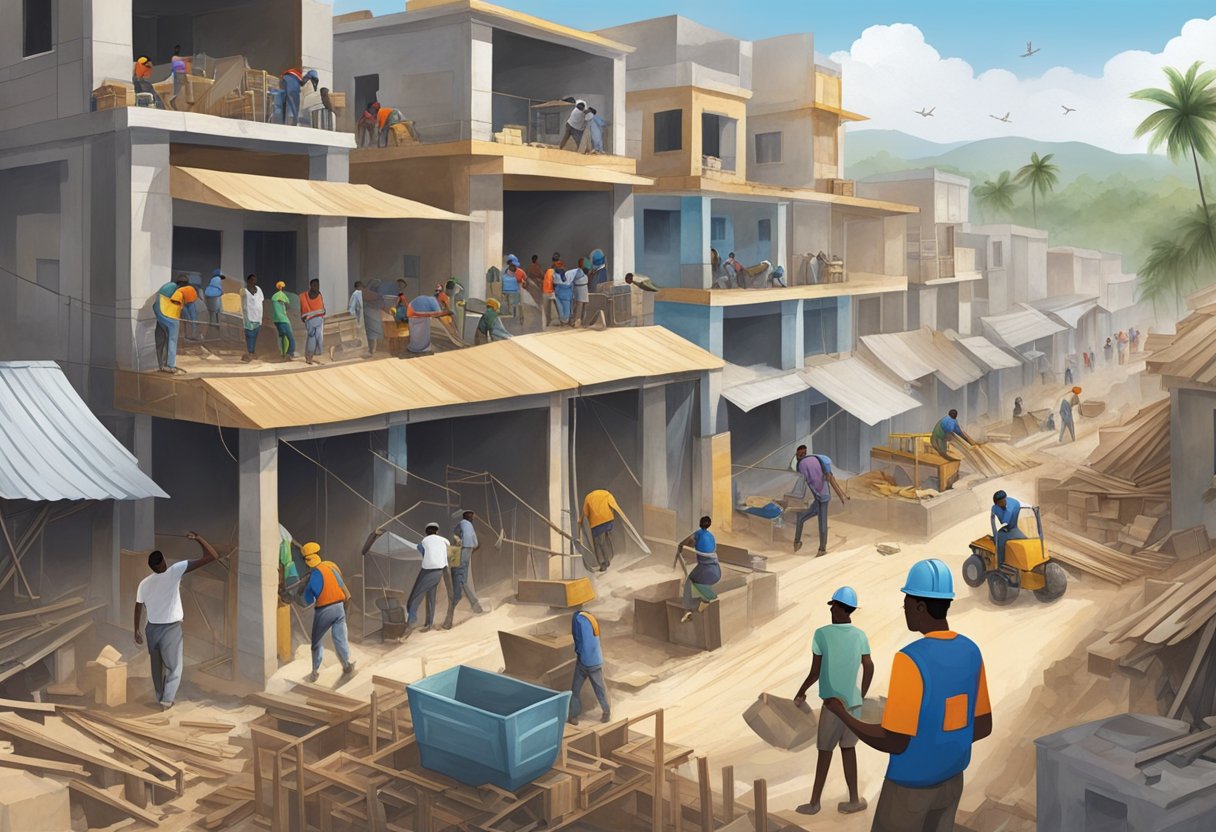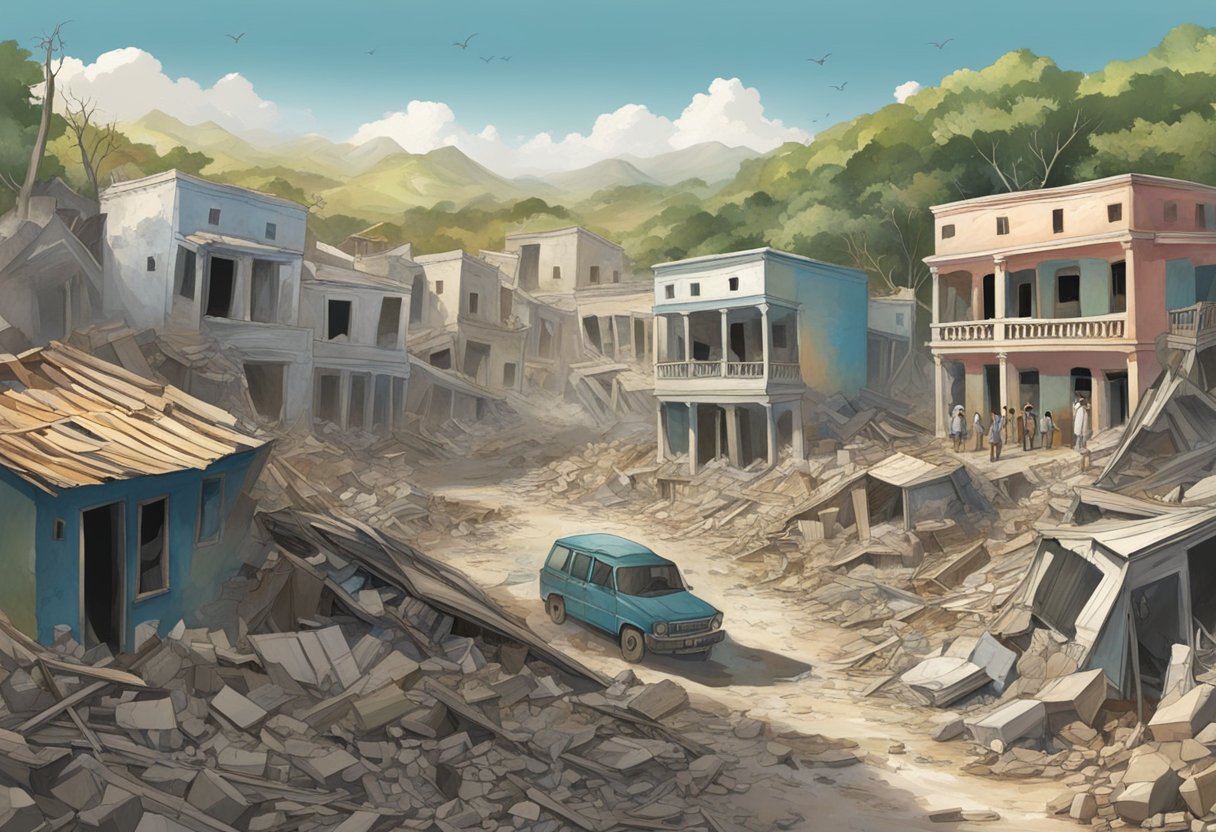The 2010 Haiti Earthquake Disaster: Efforts and Challenges in Rehabilitation

On January 12, 2010, a devastating 7.0-magnitude earthquake struck Haiti, leaving a profound impact on the nation. The disaster claimed the lives of an estimated 220,000-230,000 people, caused several hundred thousand injuries, and left nearly 1.5 million people homeless. This tragedy highlighted the deep-rooted issues of chronic poverty, rapid urbanization, and political instability that already plagued the country.
Haiti, a nation frequently battered by natural disasters, faced enormous challenges in the wake of the earthquake. The key takeaway from this catastrophic event was the crucial need for strong national leadership in disaster response and recovery efforts. The international community rallied to provide aid, but the complexities of Haiti's social and economic conditions made rebuilding a daunting task.
A decade after the earthquake, Haiti continues to struggle with its recovery. Progress has been slow, and the effects of the disaster are still evident. The long-term rebuilding efforts underscore the importance of addressing Haiti's systemic issues to ensure resilience against future calamities.
Background of the 2010 Haiti Earthquake
The 2010 Haiti earthquake was a catastrophic natural disaster that severely impacted the nation's capital, Port-au-Prince, and the surrounding areas. Understanding the geological context and the specific effects on Port-au-Prince is crucial to grasping the full scope of this tragedy.
Geological Context
On January 12, 2010, a powerful 7.0 magnitude earthquake struck approximately 15 miles southwest of Port-au-Prince. The earthquake originated from the Enriquillo-Plantain Garden fault zone. This fault system is a major strike-slip fault, causing the earth's crust on either side to move horizontally.
The tectonic setting of Haiti, situated on the boundary between the Caribbean and North American plates, makes it highly vulnerable to seismic activity. The region had experienced similar seismic events, but none equaled the magnitude and impact of the 2010 quake. The seismic waves generated by the fault's movement caused widespread shaking, leading to extensive damage.
Impact on Port-au-Prince
Port-au-Prince, the densely populated capital of Haiti, bore the brunt of the devastation. The city's infrastructure was poorly constructed and not designed to withstand such powerful earthquakes. As a result, nearly half of all structures in the city sustained significant damage or collapsed completely.
Key government buildings, homes, schools, and hospitals were either damaged or destroyed. The poor housing conditions greatly contributed to the high death toll, estimated at over 300,000 people. Additionally, hundreds of thousands of survivors were displaced, creating a humanitarian crisis. Temporary shelters and aid were urgently needed to support the affected population.
Emergency Response and Relief Operations

The 2010 Haiti earthquake led to immediate large-scale emergency responses and extensive relief operations from various entities, including international organizations and NGOs.
UN and International Assistance
Following the catastrophic earthquake, the United Nations (UN) and several international entities quickly mobilized to provide emergency aid. The UN Office for the Coordination of Humanitarian Affairs (OCHA) played a crucial role in coordinating efforts.
The World Food Program (WFP) distributed food to millions, while UNICEF provided clean water, medical supplies, and shelter to displaced families. Additionally, the international community, including the World Bank and individual countries, pledged significant financial support for relief efforts. Telethons and public donations via various platforms, including mobile text messages, raised funds to support these operations.
Role of NGOs and Civil Society
Non-governmental organizations (NGOs) and civil society groups were instrumental in the on-ground relief efforts. Organizations like the Red Cross, Doctors Without Borders, and numerous local NGOs provided essential medical care, set up temporary clinics, and delivered necessary supplies.
NGOs coordinated their efforts with local authorities to optimize resource distribution. Civil society groups organized community support networks, offering psychological aid and helping rebuild community structures. Through these collective efforts, the collaboration between NGOs, civil society, and local communities became a cornerstone of the emergency response and recovery process. These actors played a pivotal role in stabilizing conditions in the aftermath of the disaster.
Reconstruction and Rehabilitation Efforts

Haiti's journey to rebuild after the 2010 earthquake has been marked by efforts to reconstruct its infrastructure and provide essential humanitarian aid.
Rebuilding Infrastructure
The rebuilding of Haiti's infrastructure has been a monumental task. The earthquake destroyed buildings, roads, and bridges, leaving many areas inaccessible. The Government of Haiti, with support from international organizations like the World Bank and the International Development Association (IDA), has focused on reconstructing key institutions and infrastructure.
Priority Areas:
- Educational Facilities: Schools were rebuilt to ensure children could return to their education.
- Healthcare Facilities: Hospitals and clinics were reconstructed to provide medical care to injured victims.
- Transportation: Roads and bridges were repaired to reopen vital transport routes.
These efforts were crucial in enabling the country to start moving towards recovery after such extensive destruction.
Healthcare and Humanitarian Aid
Providing healthcare and humanitarian aid was vital in the aftermath. Over 12,700 people were injured, necessitating immediate medical intervention. International agencies, including the UN and various NGOs, played a key role.
Healthcare Initiatives:
- Emergency Medical Teams: Deployed to treat injuries and prevent disease outbreaks.
- Long-term Medical Care: Facilities were established to offer ongoing treatments for trauma victims.
Humanitarian Aid Efforts:
- Food and Nutrition: Distribution of food supplies to ensure that the population's nutritional needs were met.
- Shelter: Temporary housing units were provided to those who lost their homes.
In addition, these organizations worked tirelessly to lay the groundwork for Haiti’s public health sector recovery. Support for local institutions was also reinforced to ensure long-term resilience against future disasters.
Socio-Economic Impact and Development

The 2010 Haiti Earthquake had far-reaching socio-economic impacts, which deeply affected economic growth and urban planning. This disaster highlighted both challenges and possible pathways for development in Haiti.
Economic Challenges and Opportunities
The earthquake caused severe damage to Haiti's economy. The total damage and losses were estimated at around $7.804 billion. Many businesses were destroyed, leading to massive job losses. Economic activities came to a standstill, worsening poverty levels.
Yet, the disaster also opened new avenues for economic growth. International aid flowed into the country, creating job opportunities in construction and infrastructure development. Special economic zones were proposed to attract foreign investment and boost job creation.
Key points:
- Damage estimated at $7.804 billion
- Massive job losses initially
- New job opportunities in construction and infrastructure
Urban Planning and Housing
Haiti's urban planning was poorly equipped for such a disaster. The earthquake destroyed many buildings and homes, leaving thousands without shelter. Rebuilding these structures became a primary focus.
Efforts to improve urban planning included developing safer building codes and creating more resilient infrastructure. New housing projects aimed to provide stable and secure living conditions. These initiatives are vital for long-term development and safety.
Key points:
- Destruction of homes and buildings
- Development of safer building codes
- New housing projects for stability and resilience
Disaster Risk Management and Reduction

Effective disaster risk management and reduction were crucial for Haiti after the 2010 earthquake. Addressing systemic vulnerabilities and improving emergency response efforts were top priorities.
Formulating Strategies for Resilience
Haiti had to take significant steps to build resilience. Risk assessments were conducted to identify the most vulnerable regions. Investments were made in infrastructure improvements to withstand future disasters.
Constructing stronger buildings and retrofitting older ones were essential tasks. Public awareness campaigns educated communities on emergency preparedness. Emphasis was placed on early warning systems and evacuation plans to ensure swift responses during emergencies.
International and National Coordination
Coordination between national and international bodies played a vital role. The Haitian government worked closely with organizations like the United Nations and the World Bank. These bodies provided financial aid, technical expertise, and logistical support.
Strengthening local institutions was also a priority. Training programs for disaster response teams improved local capacity. Regular drills and simulations were conducted to enhance cooperation and readiness. This collaboration helped form a robust disaster risk management framework for the future.
Cooperation and Funding Initiatives
Cooperation and funding after the 2010 Haiti earthquake were crucial in addressing immediate needs and planning long-term recovery. Global fundraising efforts and managing aid allocation were central to these efforts.
Global Fundraising Efforts
Numerous countries and organizations launched fundraising campaigns to support Haiti. A telethon hosted by celebrities like Wyclef Jean and George Clooney raised over $60 million. Donations through text messages enabled quick, small contributions from individuals worldwide. The World Bank and the European Union contributed significant funds. The International Development Association provided grants and low-interest loans.
Donor countries, including the United States and Canada, pledged generous amounts for relief. Collaborative efforts also involved private sectors and non-governmental organizations. These combined initiatives aimed to provide immediate assistance and invest in Haiti's longer-term rebuilding.
Managing and Allocating Aid
Effectively managing and allocating aid was a complex process. Various agencies, including the World Bank and the Global Facility for Disaster Reduction and Recovery, took on coordination roles. The focus was not only on humanitarian aid but also on rebuilding infrastructure. Some areas, like Port-au-Prince, had unique recovery needs that required tailored solutions.
Funding was directed toward housing, healthcare, and education systems. Collaboration between local governments and international aid groups was essential for ensuring that aid reached the right places. Ongoing monitoring and assessments helped manage funds more efficiently, ensuring that resources were utilized effectively to support those in need.
Long-Term Recovery and The Role of the International Community
The long-term recovery of Haiti following the 2010 earthquake heavily involved the international community. Various countries and organizations contributed resources, money, and expertise to aid in reconstruction and development.
Building Back Better
Efforts to "build back better" aimed to make Haiti more resilient against future disasters. The international community pledged significant funds to reconstruct infrastructure. For instance, the United States and other nations contributed to rebuilding homes, schools, and hospitals. Introducing modern building codes and practices was essential to ensure safer structures.
Multiple non-governmental organizations (NGOs) collaborated with the Haitian government to implement these new standards. Emphasis was placed on education and training for local builders and planners. This approach sought to not only rebuild but also improve living conditions and reduce future vulnerabilities.
Support from the Diaspora and Neighboring Countries
Haitian diaspora and neighboring countries, especially the Dominican Republic, played a critical role in recovery. Members of the diaspora sent remittances to support their families, which injected much-needed funds into the local economy. These remittances often went towards rebuilding homes and businesses.
The Dominican Republic provided immediate aid in the aftermath and continued to assist with long-term recovery. They supplied resources and expertise, helping to stabilize affected communities. The collaboration between the two nations highlighted the importance of regional support.
The United States also offered extensive help. They provided financial aid, human resources, and logistical support. Organizations based in the U.S. worked on various projects, from healthcare to infrastructure, ensuring a comprehensive recovery effort.
These combined forces greatly contributed to Haiti's progress, although challenges remain.
Lessons Learned and Future Preparedness
Key insights from the 2010 Haiti earthquake highlight the importance of strengthening national institutions and addressing climate change to improve future disaster response and resilience.
Improving National Institutions
The earthquake in Haiti underscored the need for robust national institutions. International aid often fails to empower local agencies. Effective disaster response requires bolstering local public and private rescue efforts.
Local institutions should be equipped with better resources and training. Strengthened coordination between national agencies and international bodies like the U.N. can optimize aid delivery. Efforts to foster resilience must prioritize building capacity within Haiti's own government and organizations.
The government’s response to subsequent disasters, such as Tropical Depression Grace, shows progress. Enhanced preparedness and improved institutional frameworks helped mitigate the impacts of later natural events. These steps illustrate the importance of long-term investment in local infrastructure and governance.
Climate Change and Its Implications
Climate change exacerbates natural disasters, making Haiti more vulnerable. Rising temperatures and shifting weather patterns increase the frequency and severity of events like earthquakes and tropical storms.
Proactive measures are needed to adapt to these changes. Early warning systems, climate-resilient infrastructure, and comprehensive disaster risk management plans are crucial. International cooperation and support from global institutions are essential to developing these systems.
Addressing climate change involves both mitigation and adaptation strategies. Reducing carbon emissions and investing in renewable energy can help curb the effects of climate change. Adaptation efforts must include community-based approaches, ensuring that local populations are engaged and informed.




